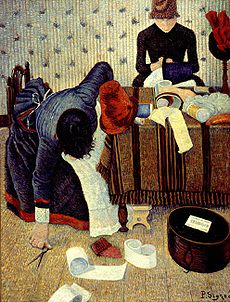Fashion design is the applied art dedicated to clothing and lifestyle accessories created within the cultural and social influences of a specific time.
Fashion design differs from costume design due to its core product having a built in obsolescence usually of one to two seasons. A season is defined as either autumn/winter or spring/summer. Fashion design is generally considered to have started in the 19th century with Charles Frederick Worth who was the first person to sew their label into the garments that they created. While all articles of clothing from any time period are studied by academics as costume design, only clothing created after 1858 could be considered as fashion design.
Fashion designers are self-employed and design for individual clients. Other high-fashion designers cater to specialty stores or high-fashion department stores. These designers create original garments, as well as those that follow established fashion trends. Most fashion designers, however, work for apparel manufacturers, creating designs of men’s, women’s, and children’s fashions for the mass market. Designer brands which have a 'name' as their brand such as Calvin Klein, Ralph Lauren, or Sean John are likely to be designed by a team of individual designers under the direction of a designer director.

